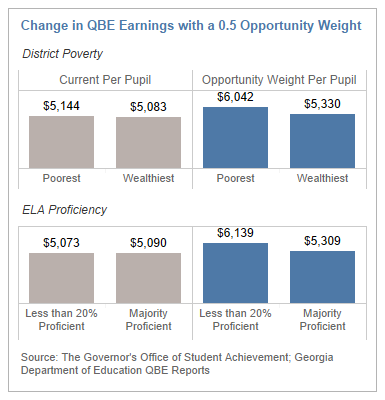FUNDING OPPORTUNITY: HOW TO BETTER SERVE GEORGIA’S AT-RISK STUDENTS
August 20, 2019
Georgia’s current method of funding academically struggling students leaves far too many behind, according to a new research report released today by Education Law Center. The report, Funding Opportunity: Replacing Georgia’s Early Intervention and Remedial Programs with Funding for Low-Income Students, recommends a funding approach based on student poverty instead of test score results as a more effective way to deliver resources to the districts most in need, while providing the flexibility for local school leaders to deliver programs and services responsive to students’ unique circumstances.
The report is the first in a new initiative in ELC’s Fair School Funding research, building on prior work examining the condition of state school finances. The new research analyzes the capacity of specific state finance systems to deliver essential educational resources to vulnerable, at-risk student populations.
Georgia is one of only eight states that does not provide additional funding to students in poverty through the state’s school funding formula. Instead, the state provides additional funding to districts for students who are eligible for Early Intervention (EIP) and Remedial Education Programs (REP) largely based on their performance on the state’s English Language Arts (ELA) or Mathematics assessments.
The “Funding Opportunity” report analyzes the design and implementation of the EIP and REP programs, as funded through Georgia’s school finance formula. The report finds that the funding allocated for these programs is insufficient to reach all students in need of additional academic supports. For example, while the majority of Georgia’s tested students were not proficient in ELA and Math, only 25% of elementary students, 15% of middle schoolers, and 10% of high schoolers participated in the EIP and REP programs. The report estimates that 700,000 students who are testing below grade level are not receiving funding through the existing formula.
In addition to underserving at-risk students, the report finds a disconnect between levels of student proficiency on state assessments and EIP/REP program participation rates. Districts with the largest proportions of non-proficient students do not have the highest participation rates. The EIP and REP programs also have a major design flaw because funding is contingent on students not demonstrating proficiency on state assessments. As soon as a student achieves a proficient score, they are removed from the program and lose the supports and resources necessary to sustain year-to-year academic improvement. Limitations on the use of funding in program guidelines may further restrict program efficacy.
The “Funding Opportunity” report recommends replacing EIP and REP program funding in Georgia’s funding formula with weighted funding based on student poverty. An “opportunity weight” that allocates per-pupil funding allocation to low income students would more effectively target resources to at-risk students most in need. Such a weight would also deliver supports and interventions for students struggling academically not just in ELA or Math and would give districts flexibility to design academic and social interventions that address a broader range of student needs. 
An opportunity weight of 0.5 – similar to poverty-based weights in other state formulas – would boost funding to support interventions and services for Georgia’s low-income students by 50% and would increase funding in the state’s lowest performing districts by over $1,000 per pupil.
The report recommends that the Georgia Legislature take the following steps:
- Direct the Department of Education to commission an independent cost study to identify the programs and services needed by at-risk students, determine the cost of the programs, and recommend an appropriate opportunity weight to best meet student needs.
- Allocate existing funding for the EIP and REP programs to support the opportunity weight based on student poverty and phase in additional funds to fully fund the opportunity weight recommended in the cost study.
- Develop accountability standards into the new legislation to ensure funding is well spent.
“Georgia has taken important steps to improve its schools in recent years, from fully funding the existing formula to raising teacher pay”, said Mary McKillip, ELC Senior Researcher and co-author of the report. “Revising the school funding formula to improve resources for economically disadvantaged students is a crucial change that will continue that progress and provide students the opportunities they deserve.”
To view the full report, policy brief, and interactive tools, click here.
ELC’s Resource Equity in the States research is supported by the W.K. Kellogg Foundation.
Press Contact:
Sharon Krengel
Policy and Outreach Director
skrengel@edlawcenter.org
973-624-1815, x 24
Press Contact:
Sharon Krengel
Director of Policy, Strategic Partnerships and Communications
skrengel@edlawcenter.org
973-624-1815, x240